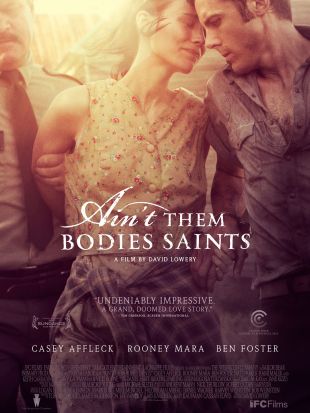
In the opening scenes of Ain't Them Bodies Saints, we bear witness to a brutal shootout between the police and three criminals holed up in a picturesque farmhouse. There's a pervasive air of romanticism in David Lowery's contemplative crime drama that draws us into the film despite the recognition that, even in those early moments, we've walked the planks of this sturdy old farmhouse before. The story of the earnest escaped convict determined to get back to his wife and child is one so tried and true that it likely transcended cliché by the late 1970s, eventually becoming classical in the language of film. From the moment the two lovers are apprehended following a tense shoot out with police, we know instinctively that their eventual reunion will not be a happy one -- and yet, due to the exceptional artistry on display, we remain emotionally engaged despite our familiarity. We sense the memories lingering in the air of that farmhouse, and they spark an elusive nostalgia deep within our gray matter. The beauty, like the devil, is in the details.
Bob Muldoon (Casey Affleck) and Ruth Guthrie (Rooney Mara) are on the run with their partner-in-crime when their spree comes to a sudden end deep in the Texas hills. When the gun smoke clears following a shootout with police, local Deputy Patrick Wheeler (Ben Foster) lies critically wounded by deadeye Ruth. Determined to save his pregnant love from spending the rest of her life behind bars, Bob claims responsibility for the shot, and receives a stiff prison sentence. A few years later, when Bob learns that Ruth has given birth to their daughter Sylvie (alternately played by sibling actors Kennadie and Jacklynn Smith), he makes a daring escape, and flees to be with them at any cost. But with every cop in the state looking for Bob and three sharp-shooting bounty hunters hot on his trail, getting back to Ruth won't be easy, even with the help of his loyal friend Sweetie (Nate Parker), the owner of a local bar. Meanwhile, after making a full recovery, sensitive Deputy Wheeler grows protective of the young mother and her wide-eyed daughter, who are currently getting by with the help of local shop-owner Skerritt (Keith Carradine), a man who may have played a bigger role in helping Bob down the path of lawlessness than he'd care to admit.

The first time we encounter Bob and Ruth, they seem like a typical young couple in the throes of a moody lover's spat. Though that playful skirmish ends with a very pointed revelation (that Ruth is pregnant) the rest of the details involving this couple quickly turn vague as we witness the defining moment in both of their lives. That carefully balanced approach to alternating bluntly explicit exposition (often spoken, occasionally shown) with purposefully abstract details is one of the key strengths of Lowrey's sturdy yet dusty screenplay -- it keeps us engaged on a few different levels psychologically, even as the characters appear to be drifting through the motions. We're never even given the motivations for the crime that leads to so much senseless suffering and bloodshed, and while at one point Bob casually states "I used to be the Devil" during the course of a conversation, we never meet that character; the only Bob we know is a lighthearted free spirit whose singular determination masks a state of misguided idealism. Perhaps Bob could be dangerous if armed and cornered, yet his only act in the opening scenes of the film is a selfless one, which makes the character much more interesting once he escapes and sets out on his inevitable course. Meanwhile, the tender relationship that begins to unfold between Ruth and Deputy Wheeler only seems to compound the guilt already weighing on Ruth.

That guilt is buried with stoic resolve by the excellent Mara, who manages to communicate quite a bit about her character in very few words. We see in her character's eyes that she knows what will happen if she tries to run away with Bob and Sylvie, but the suspicion that her idealism still overpowers her common sense is there. We see that idealism in the way she holds the box full of letters from Bob, a character we never doubt. Affleck portrays Bob as a naive narcissist who believes himself impervious to the past. If his history had not stood in such stark contrast with the longing father that we spend time with, the story in Ain't Them Bodies Saints would have felt trite. But Affleck's one-note performance plays like music against the details of Lowery's screenplay. Deputy Wheeler, too, is a character whose personality we sense from the moment he tips his hat to Ruth, and Foster's (literally) wounded performance is one of subtle depth and nuance. A revelatory conversation between Ruth and Deputy Wheeler is the film's true heart, and both actors approach the scene with an honesty that gives their relationship substance. As the guardian of the woman and the young girl, Carradine grounds the entire exercise with the stalwart charisma of an old pro.

Aside from the theatrical attention paid to writing and performance, however, it's Lowery's success in establishing a melancholy tone, and a specific sense of time and place that captures our sense of the cinematic from the sun-kissed opening shots, courtesy of talented cinematographer Bradford Young (Pariah). His imagery paints a picture of a landscape that's at once wide open and bleakly oppressive, and that creates a seductively desperate rhythm when combined with David Hart's ominously folksy score and Craig McKay and Jane Rizzo's astutely-paced editing. Yes, Ain't Them Bodies Saints exists in a very specific cinematic context, and whether it manages to evolve that context in a meaningful way may be up for debate. Even those who argue that it does not, however, will be hard-pressed to dismiss it for trying.
